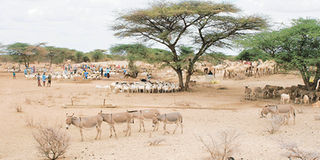Poor rains to persist, say experts

Livestock at a water pan in Garissa District in Northern Kenya. Photo/WILLIAM OERI
Weather experts on Thursday gave a gloomy outlook of the current rainfall pattern in most parts of Kenya even as 10 million Kenyans face starvation. Meteorological Services assistant director Peter Ambenje said although April is the rainfall peak period for the March to May long rains season, Nairobi and most parts of the country will continue to receive deficient rainfall “for some time”.
The forecast spells doom for farmers, who have received poor rains in the last four consecutive farming seasons. Pastoralists, whose animals have been dying in their hundreds due to lack of water and pasture, will also be devastated by the grim forecast.
Thermal power
At the same time, the cost of electricity is not likely to be reduced any time soon if the deficient rainfall persists, KenGen spokesman Mike Njeru said. “The catchment area where the Seven Forks Dam is situated is currently receiving scattered and deficient rainfall, forcing the company to rely more on thermal power generation, which is a more expensive undertaking than the traditional hydro-power generation,” Mr Njeru said.
As the poor rainfall pattern persists, Nairobi Water Company spokesman Mbaruk Vyakweli said their water rationing programme would continue. “If we continue to experience poor rains, our consumers should brace themselves for the ongoing rationing programme, which will be reviewed from time to time,” Mr Vyakweli added.
On Thursday, Mr Ambenje said: “Currently, it is only the western parts of the country (Kitale, Kericho, Nandi, Eldoret, Kakamega, Kisumu, Kisii and Busia) that are receiving enhanced rainfall, which has resulted in flooding in Kano plains... At the same time, areas in the Coastal region are also receiving some rains.”
The assistant director said farmers should expect poor harvests in most parts of the country due to the deficient rainfall. “The Ministry of Agriculture should therefore advise farmers on the best agricultural practices they should adopt as well as the appropriate crops suited for their respective areas,” Mr Ambenje said.
The official also warned: “Despite the deficient rains, people living in Nyando, Budalang’i and Kano plains should brace themselves for floods and cases of lightning strikes occurring in their areas...“Contingency measures should, therefore, be put in place to avoid any loss of lives and property in the area.”
Water rationing
Apart from water rationing and the anticipated poor crop harvest, an outbreak of cholera has been reported in parts of the country, which has resulted in the deaths of more than 55 people.
“The Ministry of Public Health is, therefore, encouraged to map possible outbreak areas and intensify surveillance of cholera and diseases related to poor sanitation,” Mr Ambenje said. Due to the poor rainfall, the cost of vegetables and fresh produce is likely to go up while the availability of the commodities will be erratic.




